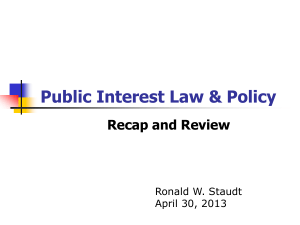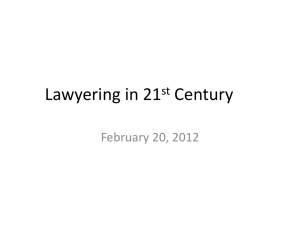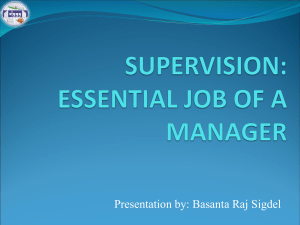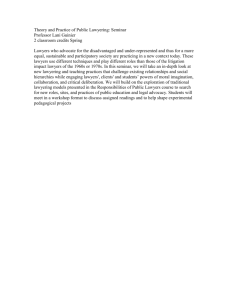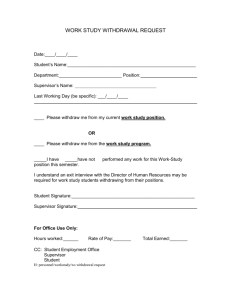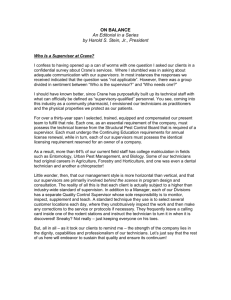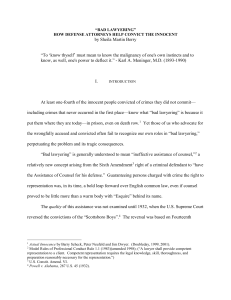Is Less More?
advertisement
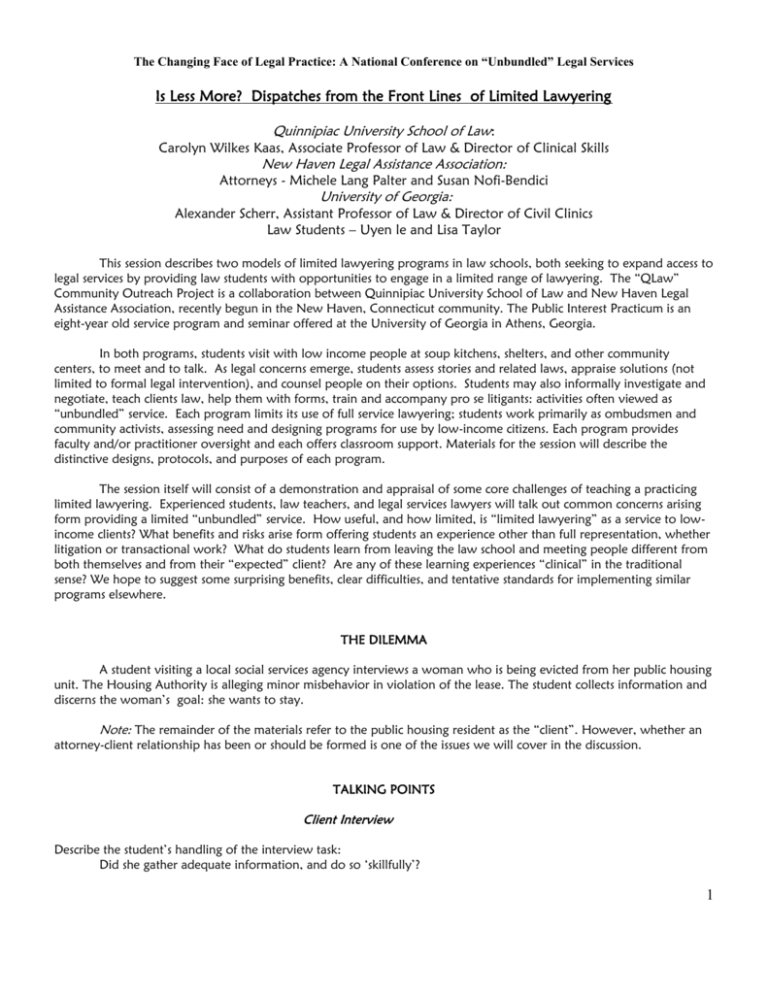
The Changing Face of Legal Practice: A National Conference on “Unbundled” Legal Services Is Less More? Dispatches from the Front Lines of Limited Lawyering Quinnipiac University School of Law: Carolyn Wilkes Kaas, Associate Professor of Law & Director of Clinical Skills New Haven Legal Assistance Association: Attorneys - Michele Lang Palter and Susan Nofi-Bendici University of Georgia: Alexander Scherr, Assistant Professor of Law & Director of Civil Clinics Law Students – Uyen le and Lisa Taylor This session describes two models of limited lawyering programs in law schools, both seeking to expand access to legal services by providing law students with opportunities to engage in a limited range of lawyering. The “QLaw” Community Outreach Project is a collaboration between Quinnipiac University School of Law and New Haven Legal Assistance Association, recently begun in the New Haven, Connecticut community. The Public Interest Practicum is an eight-year old service program and seminar offered at the University of Georgia in Athens, Georgia. In both programs, students visit with low income people at soup kitchens, shelters, and other community centers, to meet and to talk. As legal concerns emerge, students assess stories and related laws, appraise solutions (not limited to formal legal intervention), and counsel people on their options. Students may also informally investigate and negotiate, teach clients law, help them with forms, train and accompany pro se litigants: activities often viewed as “unbundled” service. Each program limits its use of full service lawyering; students work primarily as ombudsmen and community activists, assessing need and designing programs for use by low-income citizens. Each program provides faculty and/or practitioner oversight and each offers classroom support. Materials for the session will describe the distinctive designs, protocols, and purposes of each program. The session itself will consist of a demonstration and appraisal of some core challenges of teaching a practicing limited lawyering. Experienced students, law teachers, and legal services lawyers will talk out common concerns arising form providing a limited “unbundled” service. How useful, and how limited, is “limited lawyering” as a service to lowincome clients? What benefits and risks arise form offering students an experience other than full representation, whether litigation or transactional work? What do students learn from leaving the law school and meeting people different from both themselves and from their “expected” client? Are any of these learning experiences “clinical” in the traditional sense? We hope to suggest some surprising benefits, clear difficulties, and tentative standards for implementing similar programs elsewhere. THE DILEMMA A student visiting a local social services agency interviews a woman who is being evicted from her public housing unit. The Housing Authority is alleging minor misbehavior in violation of the lease. The student collects information and discerns the woman’s goal: she wants to stay. Note: The remainder of the materials refer to the public housing resident as the “client”. However, whether an attorney-client relationship has been or should be formed is one of the issues we will cover in the discussion. TALKING POINTS Client Interview Describe the student’s handling of the interview task: Did she gather adequate information, and do so ‘skillfully’? 1 Did she (at the same time) establish a working relationship with the client? Did she discover the client’s primary issues and goals? Did she give clear information about her service, and clear expectations about what she and the client would do? Was her preliminary assessment of the legal content appropriate? Did the student appear to understand the client? What assumptions did the student have in the interview about what she was to do in a first session? What kind of advance orientation and/or substantive training is evident from the student’s stance in the first interaction? How did this ‘interview’ differ from a regular, unlawyered conversation? How much more about the client did the student ask than a lawyer might? How much does it matter whether she did this? Why? What differences in role are there between interviewing and conversation? Did the student make commitments that only a lawyer should make? If not, should she have done so? If so, was that inappropriate? Did she / should she have spoken about her ‘lawyer-supervisor’? If the student never sees the client again, did this interview alone help her? What else could the student have done to make the interview, standing alone, more useful? Did the student engage the client enough for the client to want to return for further assistance? Supervision Session How did the student describe to her supervisor the interaction with the client? Did the student see what we all saw? Do you think she was motivated to report everything she “should” to enable the supervisors to supervise? Did the supervisor know enough (from the student’s account of the interaction) to help the student identify all the relevant legal and non-legal issues, as well as all the possible roles for the student to play? How can the supervisor fill in any gaps? What did the supervisors see as their role with the student: To impose upon the student what the student’s role is with the client? To let the student decide what his/her role should be? To encourage the student to include the client in this decision? Does the student’s independence, and possible non-lawyer role, in a limited representation clinic affect the supervisors’ decision of how to supervise (i.e., the choice to be more or less directive)? Should it? How did the supervisors balance client and student autonomy: · with the supervisors’ duties under the student practice rule in the state? · with the lawyer’s own decision whether to characterize the interaction as a lawyer/client relationship [albeit conducted by the student, under the lawyers’ supervision]? What should the supervisors do at this stage to help the student think through: · the ethical issues of if/when the attorney/client relationship attaches? · all the possible courses of action - from negotiation to administrative remedies to litigation? How effectively did the supervisors and student explore the issue of the difference between advocacy/ombudsperson role and that of a creative lawyer? If the person is a client of the supervisor(s), how do they handle the routine matters of supervision, case file management, and other “good practice” lessons? 2 Can the student proceed to the next step without a supervisor present? Should she? Classroom Component What lessons does this class structure enhance and emphasize? What teaching and learning goals did the teachers set? Possible goals: Expanding client/student interaction How else could the student have worked with the client? What ‘self-identifying’ language can a student use? Should she use? What are the limits of the student / client interaction? How much reliance should we place on the information gained on this one interview? What ways can students assure an ongoing relationship? Handling the client’s concerns: What was the nature of the client’s legal concern? What was the technical merit of the clients claims? What formal legal processes might assist her? What were the parameters of the client’s practical concerns? What did the client really want to have happen? What limits existed on accomplishing those goals? What informal processes might assist her? How do the client’s personality, emotional investment and personal resources affect the possible approaches? What possible courses of action would you suggest for the client? What role should the student play in pursuing those courses? How should the student and client work together? To what extent should the student not act at all? Do the chosen courses of action treat the client with ‘dignity’? Do the chosen courses of action require a lawyer’s intervention? Would pursuing any of them harm the client’s legal interests? Who should answer this question? Prospective action: To what extent should the supervisor ‘go with’ the student and client? To what extent should the supervisor meet with the client at all? If the supervisor does not meet with the client, is that unethical? is that unwise? is that good teaching? Is our service working? Assessing the quality and extent of service. How can we tell if it is working for clients? By what standards should we appraise the success of our program? How useful are ‘numbers of clients served’? How useful are monetary awards as a measure? Did our teaching goals interfere with our service to clients? Did a pause happen while student and supervisor ‘did learning’? Did the ‘teaching pause’ harm the client? Did the client know that a teaching pause might happen? Did the clients benefit from this having been a teaching situation? Did the student-supervisor interaction add to the client service? What harm did the teaching model do? 3 Is it enough for us that our students learn? Do we care about service if our students get to learn something? Can we explain to our clients why service learning helps them? Does it matter to our clients? Did our service goals interfere with our student teaching? Did the messiness of real life make precise lesson harder? Does teaching lawyering allow for precise lessons? What are those? Are there important lessons that are not so precise? What are those? Is it enough that our clients get some service? Do we care about teaching if our clients get help? Can we explain to our students why service learning helps them? Evaluating unbundled legal services What do students learn that is different from a regular clinic? What do students learn about lawyering by doing only a part of it? Can students ever learn about only a part of lawyering? What parts of lawyering can students work on? How effectively does this model teach them about counseling? What special opportunities to critique poor people’s access to legal services are presented by this particular model of service delivery? 4


